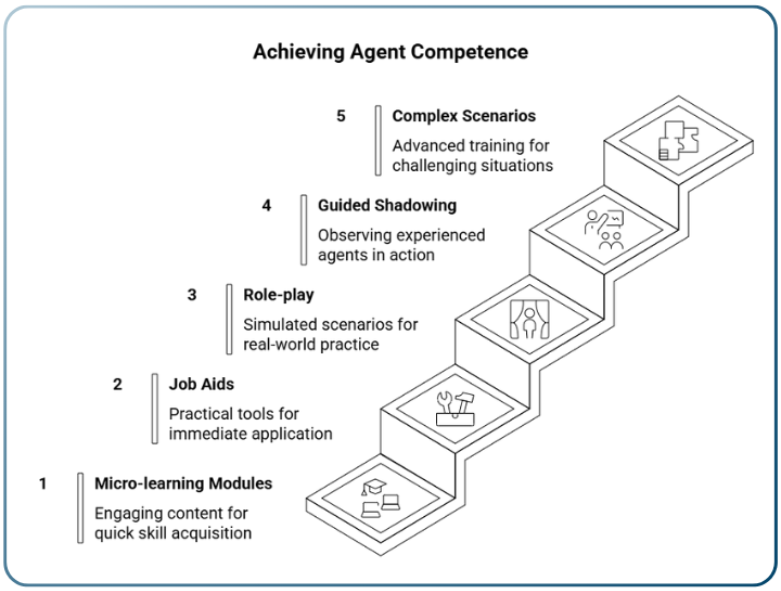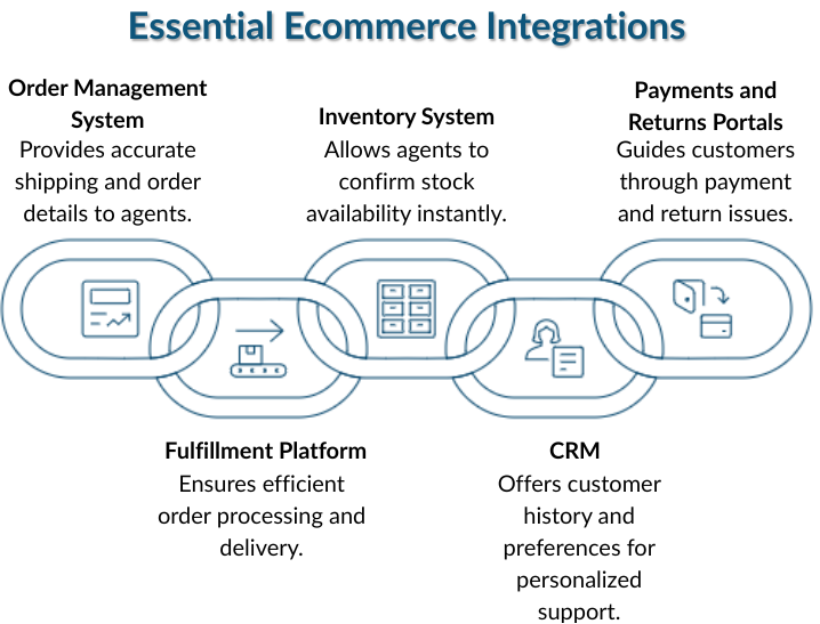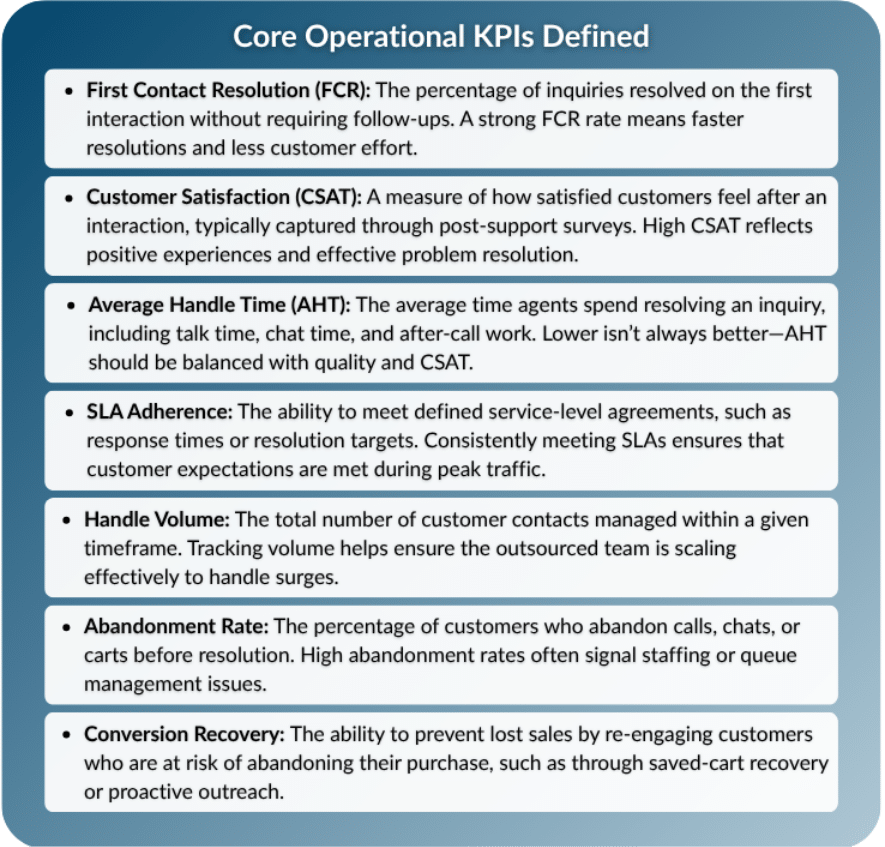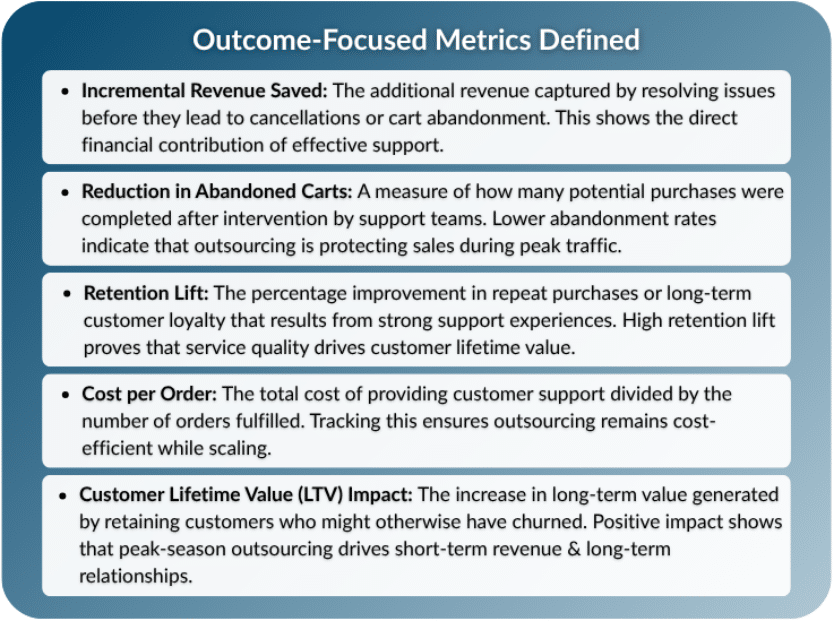Handling Increased Demand with Outsourced Ecommerce Support
Outsourced ecommerce support helps brands handle seasonal spikes in demand without sacrificing customer experience or revenue. By partnering with scalable BPO providers, companies can expand customer service capacity, maintain quality during high-volume periods like Black Friday, and free up internal teams to focus on fulfillment and growth. With the right forecasting, training, and technology integrations, outsourcing turns peak-season pressure into a competitive advantage for long-term CX success.
Read Time: 9 minutes
Table of Contents
- Why peak season planning matters for ecommerce CX
- Core outsourcing models to handle peak demand (choose based on risk profile)
- Forecasting & workforce planning: how to pre-plan for peaks
- Training, quality assurance, and maintaining brand voice at scale
- Technology & integrations that make peak season outsourcing work
- Measuring success: KPIs and ROI for seasonal outsourcing
- Common pitfalls & how to avoid them
- How ROI CX (you) does peak season differently — short pitch section
Outsourced ecommerce customer support enables brands to scale quickly, protect customer satisfaction, and capture revenue during peak season. Forecasting, training, technology, and taking a proactive approach can help companies turn seasonal surges into long-term CX advantages.
Why peak season planning matters for ecommerce CX
Almost 30% of consumers start their holiday shopping in October. Peak season arrives like a stress test for eCommerce businesses; pushing teams and customer experience strategies to their limits. Black Friday, Cyber Monday, holiday shopping, and limited time promotions put customer expectations at their peak. How well brands can manage the chaos during this period will often define their revenue for the entire year.
A company that doesn't cover all of their bases for peak season will struggle with:
- Abandoned carts
- Negative reviews
- Increased returns
- Long-term customer churn
Given these stakes, ecommerce customer support outsourcing service is a commonly chosen strategy to mitigate peak season risks. Using specialized providers helps businesses access scalable customer support solutions that maintain CX quality without adding more pressure to internal teams. Outsourced partners have everything companies need to protect revenue and strengthen brand trust during peak demand.
Core outsourcing models to handle peak demand (choose based on risk profile)
Ecommerce leaders can choose from a variety of outsourcing models, each with distinct benefits and risks. The right choice depends on the company's risk profile, infrastructure, and level of comfort with outsourcing customer experience management.
Overflow / Burst-only models
Overflow outsourcing is when a provider takes on excess contacts once the in-house team exceeds its service level agreements. This setup ensures that no customer is left waiting during unexpected surges. The advantage of this model is that activation is quick, and the in-house team can remain focused on their normal tasks. However, there may be quality challenges since outsourced agents have less context and time to deeply learn the brand. This model is great to use when demand spikes are more predictable, and the in-house team can handle the majority of the volume.

Dedicated seasonal teams (managed by vendor)
Companies can also hire and train temporary teams that are dedicated to just one brand during peak periods. These teams feel just like the in-house team, and customers cannot tell the difference. They are usually provided with consistent scripts, processes, and quality standards. The main benefit of this model is service continuity, but the disadvantages include the time it takes to scale and the risk of losing trained agents post peak season. To maximize the success of this model, businesses should provide vendors with training modules, streamlined onboarding, and easy access to knowledge bases.

Hybrid (core + flex pool + overflow)
The hybrid model blends the use of in-house staff, retained vendor agents, and overflow resources. It is great for providing flexibility and resilience to ensure changes in demand can be absorbed without compromising service. While it does strike a balance between cost efficiency and service consistency, it requires careful orchestration. Companies need to establish clear communication channels and defined responsibilities to prevent misalignment between teams.

Fully outsourced seasonal program
For some businesses, including ones with smaller internal teams, holiday customer service outsourcing makes sense. In this case, the vendor manages customer support throughout the peak period. This is great because internal staff can then focus more on fulfillment, marketing, and other critical tasks. The trade-off, however, is cost and trust. This model requires complete trust in the vendor to embody the brand's voice and standards. For companies prepared to invest, it offers a stress-free solution to managing surges.

Forecasting & workforce planning: how to pre-plan for peaks
Workforce planning and forecasting are an essential part of preparing for peak seasons. It sounds obvious, but without a plan grounded in data and foresight, even the best outsourcing provider will struggle to deliver the results a brand needs. The following sections will explore how a business can build a scalable, repeatable model for peak season customer support.
Use historical data + promo calendar
Past years' data provides a valuable baseline for forecasting. A company can predict demand surges with pretty high accuracy when they analyze the following:
- Customer inquiries
- Order volumes
- Support channels
These insights combined with promotional calendars provide a clearer picture of when and where spikes will occur. This alignment helps staffing levels mirror real-world customer demand.
Scenario planning (best/worst/most-likely)
Unfortunately, not every season is going to follow predictions, so scenario planning is critical. Leaders should model best-case, worst-case, and most-likely outcomes. For example, if a viral TikTok campaign drives a sudden product rush, what will happen if volumes double by forecast? Linking these scenarios to staffing and SLA impacts will help a business ensure they can pivot quickly. Vendors with flexible BPO services for ecommerce are especially valuable in these situations because they can adjust resources on the fly.
Staffing mix & ramp timeline
The timeline for staffing is another key thing to consider. The hiring and training process takes weeks, not just days. Businesses must plan far enough ahead to secure qualified talent and ensure agents are ready to go by the time peak season hits. Outsourcing providers can accelerate this process by maintaining a pool of pre-vetted candidates or reactivating agents familiar with ecommerce workflows. However, success still depends on setting clear expectations about training hours, shadowing, and QA readiness.
Retention strategies for seasonal hires
Retaining seasonal call center staffing across multiple cycles reduces costs and training demands. Companies can incentivize agents with a variety of things including completion bonuses, recognition programs, or priority rehire opportunities for the next season. Another benefit of having an alumni pool of high-performing seasonal workers is the company gets an experienced talent base that can be tapped year after year. The rise of remote work is also another benefit because businesses can hire agents from multiple regions to maximize coverage.
Training, quality assurance, and maintaining brand voice at scale
Even if you have enough staff in place, success still depends on how well agents represent the brand and deliver consistent experiences. The right training and quality assurance frameworks in place help to prevent service from degrading under pressure. Scaling teams is one challenge, but scaling culture, voice, and quality is another. Below, we will examine how accelerated onboarding, continuous monitoring, brand alignment, and calibration loops come together to maintain CX excellence at scale.
Accelerated onboarding frameworks
To shorten time-to-competence, many outsourcing providers use accelerated onboarding. This uses micro-learning modules, job aids, role-play, and guided shadowing. The goal is to provide agents with practical skills while quickly reinforcing brand values. This might look like a three-day training sprint that focuses on order tracking, returns, and refunds, and then gradually layering in complex scenarios.

QA & monitoring under surge
Maintaining quality during surges requires solid QA processes. You can help ensure agents meet CSAT and FCR targets by using some of the following:
- Real-time dashboards
- Live monitoring
- Random sampling of interactions
Scorecards give managers the insight they need for coaching and adjustments even during the busiest days. The shift to treating QA as an ongoing activity allows companies to maintain service quality regardless of overwhelming volume. In practice, this means setting up layered monitoring systems that catch issues before they get too big. This also means having dedicated QA specialists that can help ensure coaching is always rooted in the most current challenges.
Brand voice & escalation rules
A consistent brand voice is what helps to build trust and loyalty, and it matters even more during peak season. Any scripts provided to agents should balance empathy with efficiency. To help deliver conversations that feel on-brand even under pressure, agents should be trained on:
- Tone
- Pacing
- Problem solving styles
It's also crucial to establish clear escalation rules to empower your team to act without slowing down responses. Tiered escalation playbooks also help to reduce the number of unnecessary escalations and give staff confidence to resolve issues quickly.
Calibration & continuous improvement loops
Weekly calibration sessions bring everyone together to align on company standards. These sessions are used to make sure everyone evaluating customer interactions is applying the same benchmarks and keeps quality expectations clear. Calibration is important during peak seasons, when hundreds or even thousands of interactions are happening, and there is little room for misalignment. During this, teams will look at common issues and update knowledge bases to continuously improve workflows. This turns peak-season lessons into lasting improvements without overcomplicating daily operations.
Technology & integrations that make peak season outsourcing work
During peak shopping periods, the difference between a seamless customer experience and frustrated shoppers often comes down to technology. In order for outsourced ecommerce call center support to succeed, it must integrate with systems that power your business.
Key systems that must integrate
Effective peak season support requires connectivity across multiple critical systems. Your order management system (OMS) and fulfillment platform provide agents with accurate shipping and order information. Integration with your inventory system allows agents to confirm stock availability instantly. A connected CRM provides information on past orders, customer preferences, and support history, so agents can solve issues quickly. Lastly, links to payments and returns portals help agents guide customers through any issues. Without these integrations, agents are left to work with partial information which negatively impacts the customer experience.

Integration patterns (real-time vs batch)
Not all integrations operate in the same way and peak-season efficiency depends on balance real-time and batch processes. Real-time integrations allow agents to pull instant information to quickly respond to inquiries. Batch processes, on the other hand, take care of tasks that do not require immediate updates. The combination of these approaches is helpful in maintaining operational speed and avoiding system overloads during high-volume periods.
Security & compliance
Handling sensitive customer information requires strict security measures. Outsourced teams need to operate under least-privilege access, giving agents only permissions to items that help them perform their tasks. Safeguards should ensure that data is handled securely, with read/write protections, minimized PCI scope, and compliance with data residency regulations. This helps maintain compliance while also protecting you and your customers.
Sandbox & test processes
Before peak season goes live, end-to-end testing is critical. Using mock orders and simulated transactions is a great way for companies to ensure all integrations operate correctly. This would include testing fallback logic for API failures or system outages, to help agents provide service even if technical issues arise. A comprehensive sandbox testing process minimizes risk and helps build confidence in the system's reliability.
Observability & alerts
It's Important to monitor system health during peak season. Observability tools should track API latency, reconciliation errors, and spikes in contact volume. There should also be automated alerts that trigger failover workflows when needed. Proactive monitoring prevents small issues from turning into bigger disruptions. The result is that omnichannel customer service for ecommerce remains consistent and reliable.
Measuring success: KPIs and ROI for seasonal outsourcing
Peak-season support should be measured carefully to help you understand its impact on both operational efficiency and business outcomes. At the operational level, there are a few core KPIs that indicate whether the outsourced team is performing effectively under high demand.

These KPIs provide a clearer picture of how efficiently the outsourced team is working and whether service levels are being maintained.
It is also crucial for your business to track outcome-focused metrics to understand the bigger impact on revenue and retention. This includes looking at incremental revenue saved, reduction in abandoned carts, retention lift, cost per order, and the effect on customer lifetime value. These will connect support performance to your business outcomes, proving that seasonal outsourcing is a driver of growth.

Lastly, calculating ROI for seasonal outsourcing will require comparing baseline costs of in-house operations against the vendor's cost. Update your dashboards frequently so you can get a real-time view of the program's value and can effortlessly make adjustments as needed.
Common pitfalls & how to avoid them
Seasonal outsourcing can unlock major benefits if you can avoid common pitfalls.
A frequent challenge is late planning or short lead times. Teams struggle to perform without enough time to recruit and train.
How to avoid it: start planning at least 60-90 days ahead to give outsourcing providers time to staff, train, and test before volumes surge.
Another risk is poor integration planning. Agents cannot solve issues without access to information like orders, inventory, or customer data.
How to avoid it: Map the customer journey and confirm all systems are accessible to agents.
Misaligned SLAs are another common mistake. For example, prioritizing average handle time over customer satisfaction might speed up calls but lower quality.
How to avoid it: Build SLAs that balance efficiency with outcomes.
Knowledge management gaps can slow agents during busy periods. Not having a centralized knowledge base that is updated regularly results in customers being provided outdated answers.
How to avoid it: Use a unified knowledge hub and assign someone to oversee and push updates quickly.
The last common pitfall is failing to have a post-season transition plan. A sudden handoff back to internal teams might disrupt service and consistency.
How to avoid it: Document workflows, phase down gradually, and have debriefs to capture lessons learned for the next season.
Addressing these common pitfalls early on ensures that outsourcing enhances the customer experience.
How ROI CX (you) does peak season differently — short pitch section
For peak-season ecommerce support, ROI CX Solutions focuses on speed, reliability, and measurable outcomes. We are able to scale teams quickly without sacrificing quality. We can integrate with ecommerce technology stacks to ensure agents have total visibility into every order and customer interaction.
Our flexible pricing models help align cost with demand to provide your company with the support it needs. Our QA and governance programs allow us to continuously monitor performance as well as security compliance. Our services are driven by outcome-focused KPIs that measure revenue impact, retention, and customer satisfaction rather than just operational efficiency.
Partnering with ROI CX Solutions turns peak-season challenges into opportunities for growth. The busy season won't wait, connect with one of our experts to see how we can optimize your support and drive growth.






